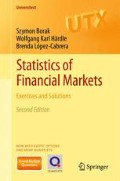Abstract
The Black-Scholes formula is one of the most recognizable formulae in quantitative finance.
Modelul Black-Scholes de Evaluare a OptiunilorUlciorul nu merge de multe ori la apă.The pitcher goes so often to the well that it comes home broken at last.
Access this chapter
Tax calculation will be finalised at checkout
Purchases are for personal use only
References
Breiman, L. (1973). Statistics: With a view towards application. Boston: Houghton Mifflin Company.
Cizek, P., Härdle, W., & Weron, R. (2011). Statistical tools in finance and insurance (2nd ed.). Berlin/Heidelberg: Springer.
Feller, W. (1966). An introduction to probability theory and its application (Vol. 2). New York: Wiley.
Franke, J., Härdle, W., & Hafner, C. (2011). Statistics of financial markets (3rd ed.). Berlin/ Heidelberg: Springer.
Härdle, W., & Simar, L. (2012). Applied multivariate statistical analysis (3rd ed.). Berlin: Springer.
Härdle, W., Müller, M., Sperlich, S., & Werwatz, A. (2004). Nonparametric and semiparametric models. Berlin: Springer.
Harville, D. A. (2001). Matrix algebra: Exercises and solutions. New York: Springer.
Klein, L. R. (1974). A textbook of econometrics (2nd ed., 488 p.). Englewood Cliffs: Prentice Hall.
MacKinnon, J. G. (1991). Critical values for cointegration tests. In R. F. Engle & C. W. J. Granger (Eds.), Long-run economic relationships readings in cointegration (pp. 266–277). New York: Oxford University Press.
Mardia, K. V., Kent, J. T., & Bibby, J. M. (1979). Multivariate analysis. Duluth/London: Academic.
RiskMetrics. (1996). J.P. Morgan/Reuters (4th ed.). RiskMetricsTM.
Serfling, R. J. (2002). Approximation theorems of mathematical statistics. New York: Wiley.
Tsay, R. S. (2002). Analysis of financial time series. New York: Wiley.
Author information
Authors and Affiliations
Rights and permissions
Copyright information
© 2013 Springer-Verlag Berlin Heidelberg
About this chapter
Cite this chapter
Borak, S., Härdle, W.K., López-Cabrera, B. (2013). Black-Scholes Option Pricing Model. In: Statistics of Financial Markets. Universitext. Springer, Berlin, Heidelberg. https://doi.org/10.1007/978-3-642-33929-5_6
Download citation
DOI: https://doi.org/10.1007/978-3-642-33929-5_6
Published:
Publisher Name: Springer, Berlin, Heidelberg
Print ISBN: 978-3-642-33928-8
Online ISBN: 978-3-642-33929-5
eBook Packages: Mathematics and StatisticsMathematics and Statistics (R0)

